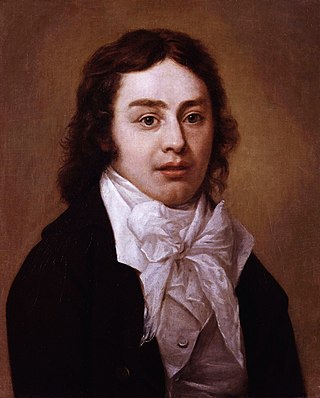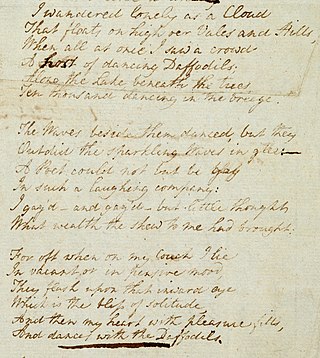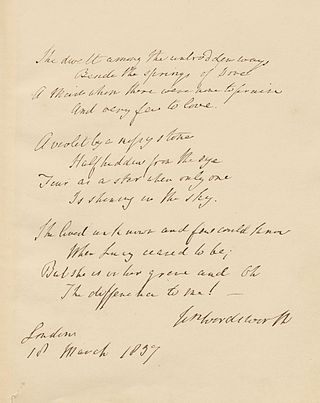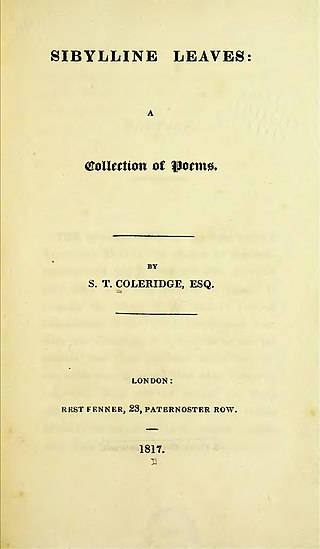| Love | |
|---|---|
| by Samuel Taylor Coleridge | |
| Written | 1798 |
| Meter | Iambic tetrameter Iambic trimeter |
| Publication date | 1799 |
| Lines | 96 |
| Full text | |
Love is a poem by Samuel Taylor Coleridge, first published in 1799 as Introduction to the Tale of the Dark Ladie. [1]
| Love | |
|---|---|
| by Samuel Taylor Coleridge | |
| Written | 1798 |
| Meter | Iambic tetrameter Iambic trimeter |
| Publication date | 1799 |
| Lines | 96 |
| Full text | |
Love is a poem by Samuel Taylor Coleridge, first published in 1799 as Introduction to the Tale of the Dark Ladie. [1]

This poem was first published (with four preliminary and three concluding stanzas) as the Introduction to the Tale of the Dark Ladie, in the Morning Post , on 21 December 1799: included (as Love) in the Lyrical Ballads of 1800, 1802, 1805: reprinted with the text of the Morning Post in English Minstrelsy, 1810, with the following prefatory note:—"These exquisite stanzas appeared some years ago in a London Newspaper, and have since that time been republished in Mr. Wordsworth's Lyrical Ballads, but with some alterations; the Poet having apparently relinquished his intention of writing the Fate of the Dark Ladye": [2] included (as Love) in Sibylline Leaves , 1828, 1829, and 1834. [1] The four opening and three concluding stanzas with prefatory note were republished in Literary Remains, 1836, [3] and were first collected in 1844. [1] For a facsimile of the MS. of Love as printed in the Lyrical Ballads, 1800, [4] see Wordsworth and Coleridge MSS., edited by W. Hale White, 1897. [5] For a collation of the Introduction to the Tale of the Dark Ladie with two MSS. in the British Library, [6] see Coleridge's Poems. A Facsimile Reproduction, &c., edited by James Dykes Campbell, 1899. [1]
It is probable that the greater part of the Introduction to the Tale of the Dark Ladie was written either during or shortly after a visit which Coleridge paid to the Wordsworths's friends, George and Mary, and Sarah Hutchinson, at Sockburn, a farm-house on the banks of the Tees, in November 1799. [1] In the first draft, ll. 13–16, "She leaned, &c." runs thus:—
She lean'd against a grey stone rudely carv'd,
The statue of an arméd Knight:
She lean'd in melancholy mood
Amid the lingering light.

In the church at Sockburn there was, as of 1912, a recumbent statue of an "armed knight" (of the Conyers family), and in a field near the farm-house there was a "Grey-Stone" which was said to commemorate the slaying of a monstrous wyverne or "worme" by the knight who was buried in the church. Ernest Hartley Coleridge finds it difficult to believe that the "arméd knight" and the "grey stone" of the first draft were not suggested by the statue in Sockburn Church, and the "Grey-Stone" in the adjoining field. [1] It has been argued that the Ballad of the Dark Ladié , of which only a fragment remains, was written after Coleridge returned from Germany, and that the Introduction to the Tale of the Dark Ladie, which embodies Love, was written at Stowey in 1797 or 1798. [1] But in referring to "the plan" of the Lyrical Ballads of 1798, [7] Coleridge says that he had written the Ancient Mariner , and was preparing the Dark Ladie and the Christabel (both unpublished poems when this Chapter was written), but says nothing of so typical a poem as Love. [1] By the Dark Ladié he must have meant the unfinished Ballad of the Dark Ladié, which, at one time, numbered 190 lines, not the Introduction to the Tale of the Dark Ladie, which later on he refers to as the "poem entitled Love", [8] and which had appeared under that title in the Lyrical Ballads of 1800, 1802, and 1805. [1]
In Sibylline Leaves , 1828, 1829, and 1834, Love, which was the first in order of a group of poems with the sub-title "Love Poems", was prefaced by the following motto:—
Quas humilis tenero stylus olim effudit in aevo, | You peruse the causeless cares that once in my tender youth |
| —Petrarch |
Coleridge wrote the following to the editor of the Morning Post:
The following Poem is the Introduction to a somewhat longer one, for which I shall solicit insertion on your next open day. The use of the Old Ballad word, Ladie, for Lady, is the only piece of obsoleteness in it; and as it is professedly a tale of ancient times, I trust, that 'the affectionate lovers of venerable antiquity' (as Camden says) will grant me their pardon, and perhaps may be induced to admit a force and propriety in it. A heavier objection may be adduced against the Author, that in these times of fear and expectation, when novelties explode around us in all directions, he should presume to offer to the public a silly tale of old fashioned love; and, five years ago, I own, I should have allowed and felt the force of this objection. But, alas! explosion has succeeded explosion so rapidly, that novelty itself ceases to appear new; and it is possible that now, even a simple story, wholly unspired [ sic ? inspired] with politics or personality, may find some attention amid the hubbub of Revolutions, as to those who have resided a long time by the falls of Niagara, the lowest whispering becomes distinctly audible. [10]

Samuel Taylor Coleridge was an English poet, literary critic, philosopher, and theologian who, with his friend William Wordsworth, was a founder of the Romantic Movement in England and a member of the Lake Poets. He also shared volumes and collaborated with Charles Lamb, Robert Southey, and Charles Lloyd.

William Wordsworth was an English Romantic poet who, with Samuel Taylor Coleridge, helped to launch the Romantic Age in English literature with their joint publication Lyrical Ballads (1798).

Suspension of disbelief is the avoidance—often described as willing—of critical thinking and logic in understanding something that is unreal or impossible in reality, such as something in a work of speculative fiction, in order to believe it for the sake of enjoying its narrative. Historically, the concept originates in the Greco-Roman principles of theatre, wherein the audience ignores the unreality of fiction to experience catharsis from the actions and experiences of characters. The phrase was coined and elaborated upon by the English poet and philosopher Samuel Taylor Coleridge in his 1817 work Biographia Literaria: "that willing suspension of disbelief for the moment, which constitutes poetic faith".

The Rime of the Ancient Mariner is the longest major poem by the English poet Samuel Taylor Coleridge, written in 1797–98 and published in 1798 in the first edition of Lyrical Ballads. Some modern editions use a revised version printed in 1817 that featured a gloss. Along with other poems in Lyrical Ballads, it is often considered a signal shift to modern poetry and the beginning of British Romantic literature.

"I Wandered Lonely as a Cloud" is a lyric poem by William Wordsworth. It is one of his most popular, and was inspired by a forest encounter on 15 April 1802 that included himself, his younger sister Dorothy and a "long belt" of daffodils. Written in 1804, this 24 line lyric was first published in 1807 in Poems, in Two Volumes, and revised in 1815.

Lyrical Ballads, with a Few Other Poems is a collection of poems by William Wordsworth and Samuel Taylor Coleridge, first published in 1798 and generally considered to have marked the beginning of the English Romantic movement in literature. The immediate effect on critics was modest, but it became and remains a landmark, changing the course of English literature and poetry. The 1800 edition is famous for the Preface to the Lyrical Ballads, something that has come to be known as the manifesto of Romanticism.
The Biographia Literaria is a critical autobiography by Samuel Taylor Coleridge, published in 1817 in two volumes. Its working title was 'Autobiographia Literaria'. The formative influences on the work were William Wordsworth's theory of poetry, the Kantian view of imagination as a shaping power, various post-Kantian writers including F. W. J. von Schelling, and the earlier influences of the empiricist school, including [[David Hartley (philosopher)|David Hartley]] and the Associationist psychology.

"The Idiot Boy" is a poem written by William Wordsworth, a representative of the Romantic movement in English literature. The poem was composed in spring 1798 and first published in the same year in Lyrical Ballads, a collection of poems written by Wordsworth and Samuel Taylor Coleridge, which is considered to be a turning point in the history of English literature and the Romantic movement. The poem investigates such themes as language, intellectual disability, maternity, emotionality, organisation of experience and "transgression of the natural."
Nationality words link to articles with information on the nation's poetry or literature.

"Ode: Intimations of Immortality from Recollections of Early Childhood" is a poem by William Wordsworth, completed in 1804 and published in Poems, in Two Volumes (1807). The poem was completed in two parts, with the first four stanzas written among a series of poems composed in 1802 about childhood. The first part of the poem was completed on 27 March 1802 and a copy was provided to Wordsworth's friend and fellow poet, Samuel Taylor Coleridge, who responded with his own poem, "Dejection: An Ode", in April. The fourth stanza of the ode ends with a question, and Wordsworth was finally able to answer it with seven additional stanzas completed in early 1804. It was first printed as "Ode" in 1807, and it was not until 1815 that it was edited and reworked to the version that is currently known, "Ode: Intimations of Immortality".

"She Dwelt Among the Untrodden Ways" is a three-stanza poem written by the English Romantic poet William Wordsworth in 1798 when he was 28 years old. The verse was first printed in Lyrical Ballads, 1800, a volume of Wordsworth's and Samuel Taylor Coleridge's poems that marked a climacteric in the English Romantic movement. The poem is the best known of Wordsworth's series of five works which comprise his "Lucy" series, and was a favorite amongst early readers. It was composed both as a meditation on his own feelings of loneliness and loss, and as an ode to the beauty and dignity of an idealized woman who lived unnoticed by all others except by the poet himself. The title line implies Lucy lived unknown and remote, both physically and intellectually. The poet's subject's isolated sensitivity expresses a characteristic aspect of Romantic expectations of the human, and especially of the poet's condition.

The Lucy poems are a series of five poems composed by the English Romantic poet William Wordsworth (1770–1850) between 1798 and 1801. All but one were first published during 1800 in the second edition of Lyrical Ballads, a collaboration between Wordsworth and Samuel Taylor Coleridge that was both Wordsworth's first major publication and a milestone in the early English Romantic movement. In the series, Wordsworth sought to write unaffected English verse infused with abstract ideals of beauty, nature, love, longing, and death.
"We are Seven" is a poem written by William Wordsworth and published in his Lyrical Ballads. It describes a discussion between an adult poetic speaker and a "little cottage girl" about the number of brothers and sisters who dwell with her. The poem turns on the question of whether to account two dead siblings as part of the family.
Frost at Midnight is a poem by Samuel Taylor Coleridge, written in February 1798. Part of the conversation poems, the poem discusses Coleridge's childhood experience in a negative manner and emphasizes the need to be raised in the countryside. The poem expresses hope that Coleridge's son, Hartley, would be able to experience a childhood that his father could not and become a true "child of nature". The view of nature within the poem has a strong Christian element in that Coleridge believed that nature represents a physical presence of God's word and that the poem is steeped in Coleridge's understanding of Neoplatonism. Frost at Midnight has been well received by critics, and is seen as the best of the conversation poems.
The Nightingale: A Conversation Poem is a poem written by Samuel Taylor Coleridge in April 1798. Originally included in the first edition of Lyrical Ballads, which he published with William Wordsworth, the poem disputes the traditional idea that nightingales are connected to the idea of melancholy. Instead, the nightingale represents to Coleridge the experience of nature. Midway through the poem, the narrator stops discussing the nightingale in order to describe a mysterious female and a gothic scene. After the narrator is returned to his original train of thought by the nightingale's song, he recalls a moment when he took his crying son out to see the Moon, which immediately filled the child with joy. Critics have found the poem either decent with little complaint or as one of his better poems containing beautiful lines.
"A slumber did my spirit seal" is a poem that was written by William Wordsworth in 1798 and first published in volume II of the 1800 edition of Lyrical Ballads. It is part of a series of poems written about a mysterious woman named Lucy, whom scholars have not been able to identify and are not sure whether she was real or fictional. Although the name Lucy is not directly mentioned in the poem, scholars nevertheless believe it to be part of the "Lucy poems" due to the poem's placement in Lyrical Ballads.

The Feast of the Poets is a poem by Leigh Hunt that was originally published in 1811 in the Reflector. It was published in an expanded form in 1814, and revised and expanded throughout his life. The work describes Hunt's contemporary poets, and either praises or mocks them by allowing only the best to dine with Apollo. The work also provided commentary on William Wordsworth and Romantic poetry. Critics praised or attacked the work on the basis of their sympathies towards Hunt's political views.

The White Doe of Rylstone; or, The Fate of the Nortons is a long narrative poem by William Wordsworth, written initially in 1807–08, but not finally revised and published until 1815. It is set during the Rising of the North in 1569 and combines historical and legendary subject-matter. It has attracted praise from some critics, but has never been one of Wordsworth's more popular poems.

Sibylline Leaves: A Collection of Poems is a volume of poems by Samuel Taylor Coleridge, first published in 1817.
"The Ballad of the Dark Ladié: A Fragment" is a poem by Samuel Taylor Coleridge, written in 1798 and published in 1834.
Attribution: